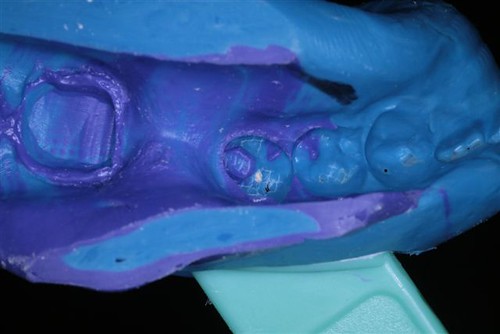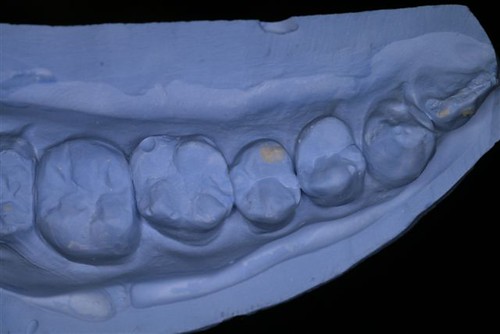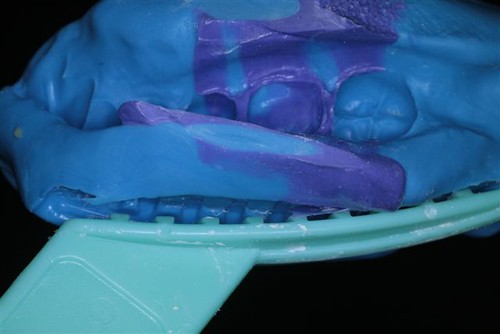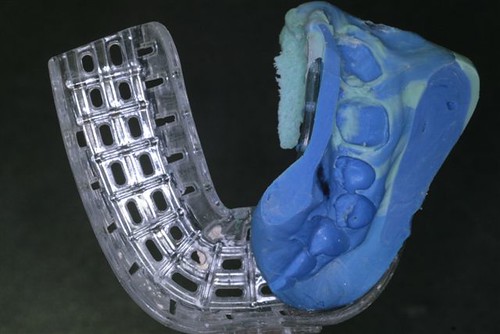There are of course many reasons for problems with impressions, I hope here to cover just a few of the main problems we have, I can however strongly recommend 3M Espe's helpsheet "Taking Better Impressions", downloadable from our webite.
Triple Trays
Many of our dentists use triple tray impressions routinely, we have a strict protocol for handling them in the lab to ensure they do not distort and that the bites locate accurately.
However, we prefer to pour 2 models of every case; one to work on and one as a check model - as can be seen from the image above, triple tray impressions often tear making a second pour impossible.

Triple trays have to be poured in plaster with both arches together, this way a lock can be made to locate the bite. However, if the patient bites through the tray and makes a hole the plaster runs through. The hole can be seen on the image above in the 5 region.

This image shows the resultant model, the yellow area on the 5 is where the opposing die stone has run through. This means that anywhere where there is a hole the models lock, this causes the model to break in this area and ultimately can lead to inaccuracies.
If you take this style of impression be please ensure that:
- There is an adequate thickness of impression material to prevent distortion
- The type of tray used has an imperveous membrane between the arches to prevent the models locking
- The impression material is stuck to the tray
Quadrant Impressions
The problem with quadrant impressions is achieving an accurate bite. even with a good squash record the models have a tendency to rock. If, as a dental team, we are looking for the highest quality we would like to recommend that we find an alternative to quadrant impressions.
Another problem with quadrant impressions is there is half the arch missing...obviously! This means we can only equilabrate the restoration in working side occlusion, we are not able to do balancing side as the teeth which provide the guidance for this are missing. Once again this can lead to a compromise in quality.
The impression in this photo is also so small that we have very little to go on by way of reference. We can see so few teeth that even a working side occlusal balance will be difficult to achieve.

Lack of Impression Detail
The following information is taken from the 3M Espe trouble shooting guide "Taking better impressions", this excellent guide can be downloaded from our website.
The following information is taken from the 3M Espe trouble shooting guide "Taking better impressions", this excellent guide can be downloaded from our website.
Visual Appearance: Muted detail reproduction.
Result: Crowns may be too tight, or loose, and not fit correctly.
CAUSES & SOLUTIONS
For Polyether materials
Substances with pH <4
For all impressions
Impression material stored at elevated temperature.
Store impression material at room temperature.
Impression material stored at too low a temperature (prolongs the setting reactions, changes viscosity and requires exceptionally
high extrusion forces for automix materials).
Keep impression material at a temperature of
18°C/64°F at least one day prior use.
Thick blood/saliva pooled around prep.
Remove blood and saliva prior to making impression.
Use 2-step impression technique.
Inadequate retraction of sulcus around prep.
Use good retraction technique, with proper moisture control.
Exceeding the working time.
Follow manufacturer's working time specifications.
Choose material with longer working time.
Inadequate disinfection effects surface quality (detail reproduction) and
dimensional stability.
Use water based disinfectants according to FDA guidelines.
At SBO we're dedicated to getting the best from every aspect of dentistry... hense this blog... To get the most from your dentistry give us a call on 01707 663293
Regards,
Mark
Substances with pH <4
For all impressions
Impression material stored at elevated temperature.
Store impression material at room temperature.
Impression material stored at too low a temperature (prolongs the setting reactions, changes viscosity and requires exceptionally
high extrusion forces for automix materials).
Keep impression material at a temperature of
18°C/64°F at least one day prior use.
Thick blood/saliva pooled around prep.
Remove blood and saliva prior to making impression.
Use 2-step impression technique.
Inadequate retraction of sulcus around prep.
Use good retraction technique, with proper moisture control.
Exceeding the working time.
Follow manufacturer's working time specifications.
Choose material with longer working time.
Inadequate disinfection effects surface quality (detail reproduction) and
dimensional stability.
Use water based disinfectants according to FDA guidelines.
At SBO we're dedicated to getting the best from every aspect of dentistry... hense this blog... To get the most from your dentistry give us a call on 01707 663293
Regards,
Mark


What protocol would you suggest for cleaning impressions and other pros items when they leave the dental surgery, before going to the lab and before returning to the Dental Practice.
ReplyDelete